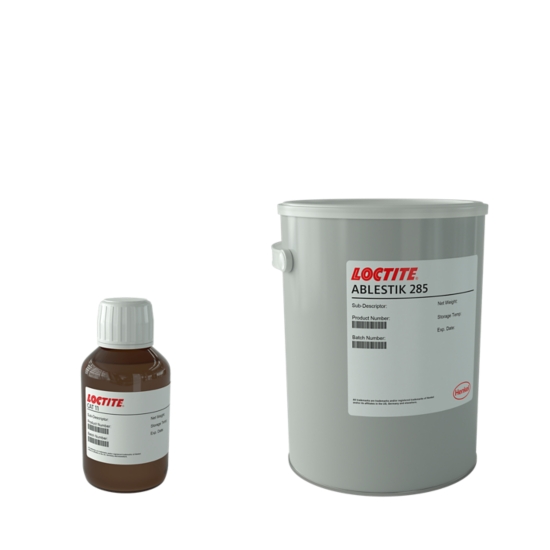LOCTITE ABLESTIK 285 CAT
Harmonization Code : 3506.10.00.00 | Prepared glues and other prepared adhesives, not elsewhere specified or included; products suitable for use as glues or adhesives, put up for retail sale as glues or adhesives, not exceeding a net weight of 1 kg
Main features
- Thermally conductive
- Non-sag
- Resin versatility
Product Description
LOCTITE® ABLESTIK 285 CAT adhesive is designed for assembly applications that require thermal management. It is also recommended for low stress bonding applications. This is a very low CTE material (~27ppm), with two components that has cure schedules and end properties that depend on the accompanying catalyst.
LOCTITE ABLESTIK 285 CAT can be used with a variety of catalysts such as CAT 11 or CAT 27-1. For more information on mixed properties when used with other available catalysts, please contact your local technical service representative for assistance and recommendations. The specifications on this page refer to the 27-1 combination.
Cure Schedule
- With CAT 27-1: 4 hours @ 120°C
Technical Specifications
| Thermal Properties | |||||||
| Glass Transition Temperature (Tg) Glass Transition Temperature (Tg) The glass transition temperature for organic adhesives is a temperature region where the polymers change from glassy and brittle to soft and rubbery. Increasing the temperature further continues the softening process as the viscosity drops too. Temperatures between the glass transition temperature and below the decomposition point of the adhesive are the best region for bonding. The glass-transition temperature Tg of a material characterizes the range of temperatures over which this glass transition occurs. | 110 °C | ||||||
| Thermal Conductivity Thermal Conductivity Thermal conductivity describes the ability of a material to conduct heat. It is required by power packages in order to dissipate heat and maintain stable electrical performance. Thermal conductivity units are [W/(m K)] in the SI system and [Btu/(hr ft °F)] in the Imperial system. | 1.1 W/m.K | ||||||
| |||||||
| Electrical Properties | |||||||
| Dielectric Strength Dielectric Strength Dielectric strength is measured in kV per mm and is calculated by the Breakdown voltage divided by the thickness of the tested material. Those two properties go hand in hand and while Breakdown voltage is always thickness dependent, dielectric strength is a general material property. As an example, the dielectric strength of Polyimide is 236 kV/mm. If we place 1mm of Polyimide between two electrodes, it will act as an insulator until the voltage between the electrodes reaches 236 kV. At this point it will start acting as a good conductor, causing sparks, potential punctures and current flow. | 23 kV/mm | ||||||
| |||||||
| Mechanical Properties | |||||||
| |||||||
| |||||||
| General Properties | |||||||
| Work life @25°C Work life @25°C Work life is the amount of time we have to work with a material until it is no longer able to be easily worked and applied on a substrate. It is based on the change in viscosity and it can rely on the application requirements. | 4 hours | ||||||
| |||||||




